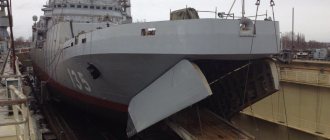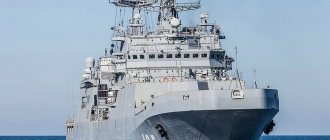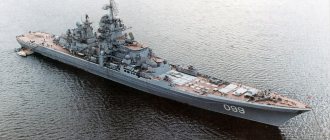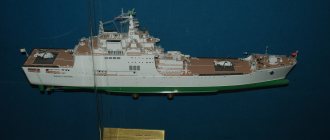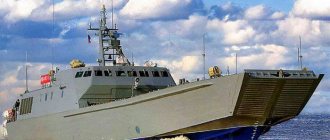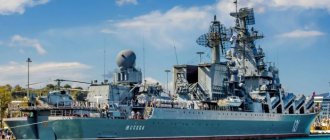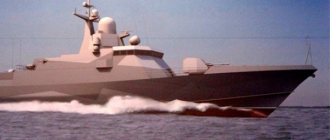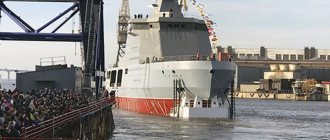The parameters of the first Russian universal landing ships (UDC), which are planned to be laid down in Crimea in 2022, have become known. A vessel of this type will be able to carry over 20 heavy helicopters and will be capable of transporting up to two reinforced marine battalions of about 900 people. The ship will also receive a docking chamber for landing boats, TASS reports, citing a source in the shipbuilding industry.
Another agency interlocutor said that the displacement of the UDC will be greater than planned: about 25 thousand tons with a length of about 220 meters. It was previously reported that the displacement of helicopter carriers could be about 15 thousand tons. The source added that the Navy issued tactical and technical specifications for two such ships. They are expected to be laid down in May 2022 in Kerch.
Prerequisites for the creation of UDC equipped with helicopters
The end of World War II brought into the world a new order consisting of a two-pole system. The Soviet Union and the United States received the status of the strongest countries in the world, competing with each other in all parameters - technology, economy, living standards and of course the armed forces. One of the new inventions of that time was helicopter carriers.
The United States of America was the first to come to this. The successes of landing airborne brigades by helicopter in the Korean War of 1951-1953 showed and emphasized the importance of air mobility of troops in hot spots. As a result, the Pentagon decided to rebuild old aircraft carriers, destroyers and cruisers into a new type of ship, which in the future would be called a “helicopter carrier.”
In terms of general characteristics, this new type of ship has common features with two other classes of ships - an aircraft carrier and a landing ship. However, after America's failure in Vietnam, the United States could not sit back and do nothing. Conventional helicopter carriers did not live up to the hopes of the US Navy command. The command of the sea giant created a new type of ship, which gained versatility in landing operations.
Landing assault ships, and after them universal landing ships, became the embodiment of the dream of any assault on the coast. They were versatile because they had the ability to support and deliver attack helicopters, passenger helicopters, infantry support ships, marines and armored vehicles, including tanks. With the advent of vertical or short take-off aircraft, universal landing ships were able to carry even these on deck. In other words, a class of ships appeared that was able to combine aviation, ground and naval forces into one. Moreover, they have the ability to be military hospitals.
The laid down UDC of project 23900 began to grow rapidly
The Russian Empire, the Soviet Union and modern Russia had no luck with aircraft-carrying ships. A lot of projects were developed from the end of the 19th century to the first quarter of the 21st century, but only the USSR had aircraft-carrying ships in decent quantities in the period from the mid-60s to 1991.
Today, the Russian fleet has only one aircraft carrier. But time passes, and the Russian fleet is thinking about replacing the Admiral Kuznetsov. In addition, two universal landing ships - UDC - project 23900 were laid down. We will talk about the vicissitudes in their design and construction in this article.
A little history
You can read in detail about the history of aircraft carriers in the Russian Empire and the Soviet Union in the articles “ History of Russian aircraft carriers. Start
","
History of Russian aircraft carriers.
The era of Gorshkov ", "
History of Russian aircraft carriers.
The last Soviet aircraft carriers " and "
History of Russian aircraft carriers.
Future Russian aircraft carriers ." The last article talks about several options for the aircraft carrier project, which should replace the Admiral Kuznetsov in the Russian Navy. The decision was finally made to build an aircraft carrier based on the Storm project. However, the start date for construction has not yet been determined. At the same time, Russian admirals came to the conclusion that it was necessary to have another class of aircraft-carrying ships in the fleet.
Universal landing ships
UDCs are multifunctional ships armed with helicopters of various classes. In the United States, the issue of equipping the America-type UDC with F-35 vertical take-off and landing aircraft is being considered, but at the same time the UDC will acquire the characteristics of a light aircraft carrier. Initially, amphibious helicopter carriers appeared as the embodiment of the concept of over-the-horizon landing. The fact is that since the 60s - 80s of the twentieth century, coastal defense has not allowed landing troops from conventional landing ships. The ships will simply not be given the opportunity to approach the shore. Let us make a reservation that we are talking only about those sections of the coast where modern coastal missile and artillery mobile systems are located. Traditional landing ships and boats are still used to land troops on unprotected parts of the coast. If there is a need to land troops on the coast, covered by modern coastal defense systems, the so-called vertical over-the-horizon landing is used. For this purpose, marines are landed by helicopters from helicopter landing ships and universal landing ships from a distance of 100 - 200 km from the coast. The equipment for it is delivered either on hovercraft landing craft or on ordinary landing craft. Helicopters for various purposes, hovercraft landing boats and simply landing boats are based on universal landing ships. Thus, the UDC carries out a landing while being outside the destruction zone of coastal defense assets. The task of the landing force is to seize a bridgehead and allow traditional landing ships with the main forces to approach the captured coast.
On this topic
6618
Focus on the “urban agenda”
VEB.RF is expanding its geography: projects that are important to people are being implemented with regions and cities
In the 21st century, military equipment is characterized by versatility. Therefore, modern UDCs, in addition to premises for landing troops, have an equipped hospital on board, and combat information and control systems - BIUS - make it possible to carry out not only landing operations, but also a number of other operations - landing and supporting peacekeeping forces, assistance in case of natural disasters, transportation and supply humanitarian assistance, performing staff functions. UDCs are called force projection ships.
This kind of ships - large and not very large - are part of the fleets of many countries: the USA, Great Britain, France, Italy, Japan, China, South Korea, Spain, Australia. Such a ship is also being built for the Turkish fleet. The need to create such ships has also been recognized in the Russian Navy. For the sake of fairness, it must be said that the UDC topic was also worked on in the Soviet Union. In the 70s - 80s of the twentieth century, the Project 11780 UDC was developed. This UDC was a variant of the Soviet aircraft-carrying cruisers of the Project 1143 family and was a response to the American Tarawa-class UDCs. Therefore, he received the unofficial nickname “Ivan Tarawa” from sailors and developers. But in the 21st century they decided to build ships abroad. In an era when confrontation had not yet reached the absolute level, a competition was held in Russia among foreign UDCs. Ships from France, Holland and South Korea took part in it. The competition was won by the French Mistral-type UDC. The French Navy has three ships of this type. The French agreed that the aft parts of the UDC would be built in St. Petersburg and towed to France. The contract for the construction of two Mistrals was signed in 2011. The ships were ready for transfer to the Russian Navy in 2015. They were named “Sevastopol” and “Vladivostok”; crews were formed for them and arrived in France to train and receive the ships. But the “Russian Spring” broke out, Crimea became part of Russia, and the President of France decided not to transfer the UDC to Russia, terminate the deal and return the money. Much has been written about this story on the Internet. Let us note only two facts - Sevastopol and Vladivostok were purchased by Egypt with money provided for this by Saudi Arabia, and, according to the terms of the contract, a set of Mistral drawings remained in Russia.
Project 23900
Immediately after the termination of the deal with France, the Commander-in-Chief of the Navy announced that analogues of the Mistrals would be built in Russia, since this class of ships is objectively needed by the fleet. Design has begun. At the International Naval Shows in St. Petersburg, first concept models appeared, and then models of ships offered to the fleet by industry as UDCs. Two projects competed - “Surf” from the Nevsky Design Bureau and “Avalanche” from the Krylov State Scientific Center. At first it was about ships with a displacement of 15,000 tons, later 30,000 tons.
Project 23900 UDC model (photo: Andrey Maksimov)
In the end, at the 2022 salon, the Project 23900 UDC model, code “Priboi,” was presented, which met the requirements of the fleet. Up to 16 helicopters can be based on its board - anti-submarine or rescue Ka-27, landing Ka-29, AWACS Ka-31 helicopters and attack Ka-52K Katran helicopters. In the future, a new carrier-based helicopter from the Design Bureau named after them will be based on them. Kamov Ka-65 "Lamprey". The ship carries four Project 11770 air-cushion landing craft "Serna" or four Project 12061 hovercraft code "Moray". In special cases, he can take four boats of project 02510 type BK-16/BK-18. The UDC can carry 1,000 marines and up to 75 units of military and automotive equipment. As a weapon of self-defense, the UDCs are equipped with one 100-mm universal artillery mount A-190, and two to three anti-aircraft missile and gun systems "Broadsword", or "Pantsir-ME".
On this topic
8445
National Nariv
Sharia reigns in mono-ethnic Crimean Tatar settlements and mountains of weapons are waiting in the wings
In July 2022, the laying of two UDCs of Project 23900 took place at the shipbuilding plant in Kerch. The contract value is more than 100 billion rubles. For many, the choice of plant raised questions. But in fact, everything is logical. There were four shipyards in the Soviet Union that built ships of increased complexity. All the country's nuclear icebreakers (except Taimyr and Vaygach) were built at the Baltic Shipyard in St. Petersburg. At Sevmash in Severodvinsk - all nuclear-powered ballistic missile submarines and most of the nuclear-powered cruise missile submarines and nuclear-powered torpedo submarines. All aircraft-carrying ships of the Soviet Union were built at the Black Sea Shipyard in Nikolaev (now Ukraine). But there was also a fourth shipbuilding plant in the city of Kerch. This plant has a dry dock 300 meters long, which made it possible to build at Zaliv a series of the first Soviet supertankers of the Crimea type, Project 1511, with a displacement of 180,000 tons. The nuclear-powered lighter carrier "Sevmorput" was built there on the Zaliv. True, during the Ukrainian period the plant fell into disrepair, but is now being actively restored. The laid down UDCs were named “Ivan Rogov” and “Mitrofan Moskalenko”. These names were borne by two large landing ships of the ocean zone of Project 1174, code “Rhinoceros”.
Project 23900 UDC model (photo: Andrey Maksimov)
Project 23900 UDC model (photo: Andrey Maksimov)
Questions
The main question, surprisingly, can be formulated as follows: “Has Project 23900 been developed?
" This formulation of the question has a right to exist. Developing a project for any warship, especially an aircraft carrier, is a complex and lengthy matter. After approval of the project, it is extremely undesirable to radically change the tactical and technical data of the ship, since this entails the creation of an essentially new project.
On September 11, 2022, TASS, citing two sources, reported: “ Two UDCs with a displacement of 15,000 tons, for the first time in Russian history, are planned to be laid down at a shipyard in Kerch in 2020
"
Sources said the ships will carry 10 helicopters of various classes and have a docking chamber for landing craft. With an announced displacement of 15,000 tons, the number of helicopters did not raise any questions. In January 2022 - 6 months later - the Commander-in-Chief of the Russian Navy, Admiral Nikolai Evmenov
, already stated that the displacement of the Priboys would be more than 20,000 tons, and that their characteristics would surpass the French Mistrals.
In July 2022, the laying of two ships took place, which was observed by the President of Russia. It can be assumed that ships with a displacement of 20,000 tons were laid down. But what’s surprising is that on August 14, 2022, the same TASS, citing an unnamed source, reported: “ The tactical and technical characteristics of the ships have changed noticeably during the design. Their displacement grew to more than 30,000 tons
" That is, it increased one and a half times from the declared one. Let us emphasize once again - the design of a modern warship is a complex document that links together thousands of parameters - the power of generators to provide energy to all consumers of the ship, the most complex diagrams of pipelines, power and information cables, hundreds of kilometers of pipes and cables for various purposes, and much more. One example. When designing a ship, all the necessary cables are laid in the so-called cable routes. The warship is divided by bulkheads into watertight compartments. When the cable route crosses a bulkhead, it is sealed to ensure the compartment is watertight. After this, it is no longer possible to insert at least one more cable. Of course, several backup cables are laid in the cable route, but this will not help with constant changes to the project.
Project 23900 UDC model (photo: Andrey Maksimov)
On this topic
11152
Riddles of "Varan"
A project for an aircraft-carrying ship has been created in Russia, which has more questions than answers.
At the same time, according to TASS, the number of helicopters increased to 16. The air wing includes some attack and reconnaissance drones, which have not yet been developed.
Meanwhile, the project continued to grow rapidly. In December 2020, Deputy Minister of Defense Alexey Krivoruchko
stated - “
Under the leadership of the President of the Russian Federation, two universal landing ships of a new project with a displacement of 40,000 tons each were laid down
.”
What's happening? Only one, very bad analogy comes to mind with the stories of the construction of the large landing ship of project 11711 “Ivan Gren”. The military radically changed the technical requirements for the ship so many times that the BDK with a displacement of about 5,000 tons took eight years to build! I really wouldn’t want “Priboi” to face the same fate. What project were the ships laid down for? Does he exist at all? If the stated construction completion dates (2025 and 2027) are met, then the designers must make changes literally “on the knee,” which is fraught. Or is it that the fleet has a dual position in relation to the UDC - on the one hand, the fleet needs such ships, on the other hand, the fleet has not yet decided what tasks it should solve, and in what conflicts such a ship should take part? Is it needed as a means of over-the-horizon landing, or as a force projection ship somewhere in Africa? Putin also casts a fog
, said when laying down the ships: “
They are good, modern.
We even planned to remake them a little and use them for other purposes. Practically the same thing, only for different purposes. But now I won’t talk about it yet .” Well, a floating hospital cannot be the main purpose of the UDC.
So what was the President hinting at with his mysterious phrase? A possible answer is that it is not UDCs that are being built in Kerch, but light aircraft carriers. The project of the heavy aircraft carrier "Storm" now seems to be beyond the country's means. Its construction is constantly being postponed (as, indeed, the nuclear destroyer Leader). Maybe, indeed, it is planned to follow the American path and equip the UDC with vertical take-off and landing aircraft - VTOL. Our fleet has such a machine. This is the Yak-141. Moreover, during the years of devastation this aircraft was sold to the USA, and using the developments of the Yak-141, the Americans made their own F-35. Of course, the Yak-141 flew in the late 80s and early 90s, and the developers of the new aircraft will build on the developments of the Yakovlevites. No wonder Yuri Borisov
back in 2022, he announced that Russia was developing a new VTOL aircraft. Borisov suggested that such aircraft should be put into service in 2025 - 2027. And this is exactly the time when “Rogova” and “Moskalenko” should be launched in Kerch.
Conclusion
Time will tell what will ultimately work out. The first answers will appear when the hulls of the ships on the slipway are formed. The fact that this order has priority is evidenced by the fact that the Zaliv Shipyard has transferred part of the civilian orders to other plants. I really want the construction of Project 23900 to not turn out to be a long-term construction project.
general characteristics
A relatively new type of warship, not used by every country with access to the sea or ocean. The main reason is the need for modern technology and, of course, the high cost of building and maintaining such a giant, second only to an aircraft carrier in these parameters.
A helicopter carrier is a type of warship that carries helicopters, military equipment and detachments of landing troops for certain purposes over distances that helicopters themselves cannot fly.
Moreover, helicopter carriers have the ability to find the location of submarines with the help of air support. However, the rapid growth of technology and the advent of nuclear submarines have made the latter characteristic of helicopter carriers less important since nuclear submarines have torpedoes with a longer range and diving depth of the submarine. In this regard, the main task remained to assist in the deployment of airborne troops. Until the second half of the 1960s, helicopter carriers were rebuilt aircraft carriers and cruisers. It was only after the Vietnam War that full-fledged ships of this class began to be built.
In the modern world, universal landing ships are used exclusively in group actions. Due to their size, helicopter carriers are easy targets. Universal landing ships need combat vessels that could accompany and protect them in possible adverse conditions. In order to explain the structures of this type of sea giants, we will analyze their main examples according to the countries that have them.
USSR helicopter carriers - anti-submarine cruisers
The USSR, as a superpower during the Cold War, was not a super power in naval terms. The strength of the USSR mainly consisted of ground forces, aviation and nuclear/ballistic weapons. Nevertheless, the USSR had a couple of helicopter carriers and anti-submarine cruisers “Leningrad” and “Moskva”, as well as the “Khalzan” that never came to fruition.
- The Moscow and Leningrad PCs went into operation in 1967 and 1969. Both ships were under the Command of the Black Sea Fleet. However, both were involved far beyond the Black Sea.
- PC "Moscow" completed 11 combat tours in the Mediterranean Sea and many other missions and exercises in other seas. In 1972, the first Yak-38 aircraft in the history of the USSR landed on board the ship. In 1996, it was sold to India for scrap metal.
- PC "Leningrad" completed 15 long-term combat services, which took place in different parts of the globe. The most striking example of combat service was the clearance of the Suez Canal in 1974. After the collapse of the USSR, it was sold for scrap to India in 1991.
- The Khalzan project could not be realized due to the economic decline of the USSR and the outbreak of the war in Afghanistan.
Russian Helicopter Carriers
At the moment, there is not a single helicopter carrier in service with the Russian Navy. The only copy was the Moskva PC, which remained in service with the Russian fleet until 1996.
After a change in the country's policy in the early 2010s, the Russian Federation ordered 4 Mistral-class UDCs from the French in 2011. It was planned to give the new type of ship the name “Priboy” (“Vladivostok” and “Sevastopol” are the names of the UDCs that were to be purchased from France). It was slightly modified from its French prototype. However, despite the fact that the first ship was already built in 2014, France refused to sell it due to the Crimean crisis.
"Surf"
Of course, this was not the most pleasant news for the Russian government, but on the other hand, it forced them to begin developing the construction of their own UDC. Thanks to the fact that engineers from both countries worked on the Mistral ships, the Russian Federation received the technology to build such sea giants. As a result, the UDC Avalanche project was presented at the Army 2015 exhibition. When compared with the Mistral, the domestic UDC will be slightly smaller in displacement, but will not be inferior in combat power. It is planned that the first combat ship “Avalanche” will be built in 2022.
Our UDC has only a distant resemblance to its French counterpart
The Russian project is heavier and more powerful than the French helicopter carrier. The Project 23900 Priboy has a 15-meter wider flight deck, and a meter deeper hull draft.
In addition, the Frenchman is poorly protected and is not able to withstand direct combat. That is why Paris uses such ships both as a command post and as a military hospital. The Russian UDC is much closer in functionality to that Soviet project of the eighties of the last century.
Also, the need to operate in difficult ice conditions requires completely different strength characteristics of the hull than that of the frivolous Frenchman, who was clearly not designed to rise to such high latitudes.
The French helicopter carrier is also not suitable for the Russian Navy according to basic criteria: it has only one engine room, while our warships should have two separate ones, which ensures the survivability of the combat unit during fire contact with the enemy. The Frenchman's fuel tanks are not insulated; if damaged, the fire could spread to critical components and mechanisms.
© defense.gouv.fr
The French Mistral is armed much weaker than the Russian UDC according to many basic criteria.
In addition, the Mistral's propellers are mounted on electrically driven rotary steering columns, which provide this craft with super-maneuverability. Our industry does not produce electric speakers of such power. Accordingly, the design of the main power plant of the Russian UDC will be different - most likely, a diesel-gas turbine.
US helicopter carriers: Iwo Jima, Tarawa, Wasp and America
The Iwo Jima type of warships were built in the 1959-1970s. In 1971-1978, the Tarawa UDC were built. UDC "Wasp" were built in 1987-2009. And finally, the first UDC “America” entered service with the US Navy in 2014. All ships of the last 3 types, in total 14 ships, are currently in service. The America class is the newest example of a UDC in the US Navy.
UDC type Iwo Jima
In total, it is planned to build 11 UDC "America" (at the moment 1 is built, 1 is under construction and this year it is planned to be included in the US Navy - UDC "Tripoli"). The ship's crew is 1060 people. "America" has the ability to transport up to 1,820 marine soldiers, 40 amphibious armored vehicles, 11 amphibious assault ships, 26 helicopters or 22 F35B class aircraft.
General characteristics: length - 257 m, width - 32.5 m, power - 70,000 hp, maximum speed - 22 knots (optimal 18 knots), range - 9,500 nautical forces, maximum displacement - 45,700 tons.
It has electronic weapons, Phalanx class anti-aircraft artillery, ESSM and RAM class missile weapons.
French helicopter carriers: Mistral
The well-known type of universal landing ships-helicopter carriers became a real brand after the Russian Navy ordered 4 such warships from the French. The French Navy is one of the leading surface fleets in shipbuilding. The Mistral UDC is a striking example of this, replacing the outdated Joan of Arc type.
"Mistral" is an example of a modern universal landing ship. Fully equipped with the latest weapons and technology, this type is positioned to be a leader in this aspect. The Mistral can simultaneously contain 16 NHI NH90 and Eurocopter Tiger class helicopters, 70 armored vehicles, from 450 to 900 marine soldiers (depending on the time the infantry spend on the ship) and 4 landing craft. The main tasks of the ship are delivery to the destination and landing of landing groups (infantry and military equipment); maintenance and servicing of helicopters; to be a military hospital; be the center of command and control.
The Mistral has radar weapons of the DRBN-38 and MRR-3D class, missile weapons of the Simbad class, anti-aircraft artillery of the Browning and Breda-Mauser class, and artillery of the AK-630 class.
The total crew size is 160 people, 20 of whom are officers. Maximum displacement 32,000 tons (21,000 tons full), length 199 m, width 32 m, landing 64.5 m, power 20,400 hp, maximum speed 19 knots (optimal 15 knots), maximum range 10,700 nautical miles.
The first ship of this type, Mistral, was built in 2005. At the moment, there are 5 ships of this type: 3 are in service with the French Navy (Mistral, Tonner and Dixmud), 2 are planned to be sold to the Egyptian Navy (after France refused to sell them to the Russian Federation in connection with the Crimean crisis) .
What is known about the UDCs being developed in Russia?
After the ban on the purchase of the Mistral UDC from France was introduced, Russia began to develop its own helicopter carrier. It was the universal landing ship (UDC) of the Priboy project, which was first presented in the form of a model at the stand of the Russian Navy's main command at the Army-2015 forum in Kubinka near Moscow.
It was assumed that the development of the Nevsky Design Bureau would be able to successfully solve the problems of receiving, transporting and landing amphibious assault forces. “Priboy” was supposed to have Russian landing craft, air wings and weapons systems. It was expected that at least four such ships would be built.
Then it was reported that the Priboy UDC would have a displacement of 14 thousand tons with a draft of 5 m, reach a speed of up to 20 knots, its cruising range would be 6 thousand miles, and its endurance would be 60 days. On board the UDC can accommodate up to eight Ka-27 and Ka-52K anti-submarine and landing helicopters. The ship is capable of transporting up to 60 pieces of equipment and carrying on board four landing craft of Project 11770M or two of Project 12061M. The ship will be able to provide its air defense with the help of the Pantsir-M sea-based air defense system.
ZRPK "Pantsir-S1". Infographics Read more
Subsequently, the Priboy-type UDC project was presented by the Krylov State Scientific Center (KGSC, St. Petersburg) at the international military-technical forum “Army-2018”. The KGNC materials stated that the ship's displacement would be 23 thousand tons, length - 200 m, width - 34 m, speed - 14-20 knots (26-37 km/h), cruising range - 6 thousand miles, endurance - 30 days. It was assumed that the Priboi would receive an air defense system and a 76-mm artillery mount, but during the voyage the UDC would be covered by a group of attack ships. The construction of two such ships was included in the State Armament Program for 2018–2027.
“The tactical and technical characteristics of our ship are almost similar to the Mistral. At the same time, Priboy has much better combat stability indicators. The ship is even equipped with a ramp (a platform for landing troops on the shore), which can be used in case of emergency,” Alexey Litsis, head of the design department of the KGNC, told the RT channel on the sidelines of the Army-2018 forum .
In September 2022, TASS, citing sources in the shipbuilding industry, reported that two UDCs would be laid down at the Kerch shipyard in 2022. The lead ship is planned to be delivered to the fleet by the end of 2027. The agency’s interlocutor also said that the development of the technical project is in the final stage, after its completion a contract for the construction of the UDC will be signed.
Australian Helicopter Carriers: Kanimbla
Kanimbla and Manura are two Kanimbla-class amphibious assault ships of the Australian Navy. The country of origin is the United States of America. During service in the United States they were the Newport type. The Australian Navy bought these ships in 1994. In 1996, they were rebuilt from tank landing ships into helicopter carriers. In 2010, many malfunctions were identified, and therefore both ships were decommissioned in 2011.
UDC "Kanimbla" had the ability to transport up to 450 marine soldiers, up to 4 helicopters, 2 landing craft and up to 40 units of armored vehicles (including tanks).
The Kanimbla had SRBOC-class electronic weapons, Kelvin Highes-class radar weapons, Phalanx-class anti-aircraft artillery and 12.7mm machine guns, and RBS-70 class missile weapons.
The combat vessel had a maximum displacement of 8,450 tons, 168 m in length, 21 m in width, and 16,500 hp. power, 20 knots maximum speed (optimal 15 knots), 14,000 nautical miles range at optimal speed. The ship's crew consisted of 210 people.
South Korean Helicopter Carriers: Dokdo
Universal landing ships of the South Korean Navy. In general, it is planned to build 3 ships of this type, but at the moment only 1 has been built - “Dokdo”, built in 2 years and entered service with the South Korean Navy in 2007.
According to its characteristics, the ship has a length of 199 m, a width of 31 m, a maximum displacement of 18,000 tons, a maximum speed of 22 knots (optimal 18 knots), a range of 10,000 nautical miles, and a crew of 400 people.
"Dokto" has anti-aircraft missile weapons of the "ASMD" class, radar weapons of the "AN/SPS-95K" class, and anti-aircraft artillery weapons of the "Goalkeeper" class.
The UDC can receive and transport up to 720 marine soldiers, 27 armored vehicles, 4 landing ships and 10 helicopters.
Armament
In addition to combat helicopters, our UDCs will also receive serious standard weapons to ensure their own safety. Perhaps (although the appearance of the ships has not yet been finally determined), based on functional criteria, these will be two Pantsir-M air defense systems, two Broadsword air defense systems and a 100-mm A-190 artillery mount.
The French counterpart is much weaker armed. It can only “boast” of M134 mini-cannons (2 units), two Simbad launchers, and four 12.7 mm machine guns.
As we see, there is nothing similar either in form, or in essence, or in possible combat missions, or in engineering content, or in power plant between the future Russian and the long-existing and rapidly becoming obsolete French ship.
UK Helicopter Carriers: Ocean
The Royal Navy UDC Ocean is the only helicopter carrier (in service) in England. Construction of this military vessel began in 1993, the ship was launched in 1995, but only entered service with the British Navy in 1998. Queen Elizabeth II herself is considered the godmother of the helicopter carrier (in England there is a tradition of baptizing ships before they enter service).
Ocean can transport up to 18 helicopters, 830 Marines, 40 armored vehicles and 4 landing ships.
In terms of weapons, there are DS30M class rocket artillery, Phalanx class anti-aircraft artillery and M134 class machine guns.
General characteristics of the ship: length - 203m, width - 36m, maximum displacement 21,750 tons, maximum speed 18 knots (optimal 15 knots), range 8,000 nautical miles, crew - 450 people (200 of which are flight personnel).
From design to construction
Over the past few years, after the end of the Mistral story, materials on UDC’s own projects regularly appeared at domestic exhibitions. There were also statements about the ability of our industry to build such ships and about the imminent start of construction. However, until a certain time, real work was postponed.
In November last year it became known that the Zelenodolsk design bureau, part of the Ak Bars corporation, would develop a new UDC project. Already at the beginning of January 2020, materials on this project, which received the number “23900,” were demonstrated to the country’s leadership. It also became known that in the coming months the laying of two new UDCs will take place in Kerch (also part of Ak Bars).
Initially, it was reported that the ships would be laid down in May, but due to the difficult situation, these events were postponed. The signing of the construction contract has also shifted. According to domestic media reports, the Ministry of Defense signed such an agreement on May 22. For two UDCs the performer will receive approx. 100 billion rubles.
On July 20, a solemn ceremony took place in Kerch with the participation of President Vladimir Putin, representatives of the government and the Ministry of Defense. Mortgage boards are installed on sections of the future ships “Ivan Rogov” and “Mitrofan Moskalenko”.
Japanese helicopter carriers: Shirane, Haruna and Hyuga
Shirane-class helicopter destroyers, Haruna-class and Hyuga-class helicopter destroyers are examples of helicopter carriers of the Japanese Navy. "Haruna" and one of the "Shirane" have already been decommissioned from Japanese service. "Hyuga" is the latest model of the family of helicopter carriers built by Japan, therefore it would be better to talk about them.
Hyuga and Ise are the largest ships of the Japanese Maritime Self-Defense Force. They came into service in 2009 and 2011 as a replacement for their predecessors, the Haruna-class helicopter carrier destroyers. In terms of its characteristics, it is more similar to a light aircraft carrier (in some publications it is called that). Anti-submarine defense is a priority for this type of helicopter carrier.
Hyuga has the ability to transport up to 11 helicopters or vertical/short take-off aircraft. The ship is armed with radar weapons of the OPS-20С class, electronic weapons of the BIUS class, air defense of the FSC-3 class, anti-aircraft artillery of the Phalanx class, missile artillery of the ESSM class, anti-submarine weapons of the ASROC class, mines - torpedo weapons and artillery.
General characteristics: length – 197 m, width – 33 m, power – 100,000 hp, maximum speed 30 knots, maximum displacement 18,000 tons.
Construction of universal landing ships for the Russian Navy
Model of UDC "Priboi"
This year, the Russian Navy is waiting for a joyful event: the laying down and construction of two UDCs of the Priboy project should begin in Kerch. In the second half of the 2020s, the Navy should receive two UDCs: Sevastopol and Vladivostok.
The exact characteristics of the new project are still unknown. The approximate data is as follows: the total displacement of the ship is 28,000 tons; full speed – 22 knots; cruising range - 6000 nautical miles; autonomy – 60 days; crew - 320 people, in addition: up to 900 marines, up to 50 units of military equipment, up to 6 landing boats in the dock chamber; air wing: more than 20 Ka-29 landing helicopters, Ka-27 anti-submarine helicopters, or Ka-52K attack helicopters.
The news is really good. The shipbuilding industry is receiving a new major order, and there will also be work for helicopter manufacturers. For the first time since Soviet times, domestic shipbuilding receives an order to build such large ships for the Navy.
This article examines both domestic UDC projects and foreign experience, and comprehends the concept of using such ships in the Navy of Russia and foreign countries.
UDC: foreign experience
USA
As the main maritime power, the USA today has the largest fleet of UDCs, as well as experience in their design, construction and operation. To date, the US Navy has used 3 types of UDC.
UDC type "Tarawa"
The first of these were UDCs of the “Tarawa” type, built in 1971–1978. These ships had a total displacement of about 40,000 tons; engines – steam turbine unit with a power of 70,000 hp; speed up to 24 knots; cruising range - 10,000 nautical miles; crew – 1067 people; landing - 1903 marines. The regular composition of the aviation group includes 16 CH-46D Sea King helicopters, 6 CH-53D Sea Stallion helicopters and 4 UH-1N helicopters on board Tarawa-class ships. The maximum possible number of aircraft on board is 43 units.
UDC type "Wasp"
The next UDCs in the American fleet were the Wasp type. These ships were built from 1987 to 2009. A total of 8 ships were built. Characteristics of UDC "Uosp": total displacement - 40,532 tons; engines – 2 steam and 2 gas turbines with a power of 70,000 hp; maximum speed – 24 knots; cruising range - 9500 nautical miles; crew - 1147 people and 1893 marines; air wing - 30 - 32 CH-46 helicopters, 6 - 8 AV-8B aircraft or up to 46 CH-46 helicopters or 20 AV-8B aircraft.
UDC type "America"
The latest project currently under construction is the America type UDC, which has the following characteristics: total displacement - 45,700 tons; engines – 2 General Electric gas turbine units with a power of 70,000 hp; maximum speed – more than 22 knots; cruising range - 9500 nautical miles; crew – 1059 people; landing - 1871 marine soldiers; air wing - up to 29 helicopters and airplanes, or 22 F-35B fighters.
Japan
Izumo-class helicopter destroyer
The Japanese Navy has 2 types of UDCs (here they are called destroyers-helicopter carriers). The first type is the Izumo helicopter carrier destroyers. Total displacement - 27,000 tons; engines – 4 General Electric gas turbine units with a power of 112,000 hp; speed – 30 knots; crew - 470 people and 500 landing troops; air group - up to 28 aircraft (helicopters, tiltrotors, fighters).
Hyuga-class helicopter destroyer
The second type is the Hyuga helicopter carrier destroyers. Total displacement - 18,000 tons; General Electric engines rated at 100,000 hp; maximum speed – 30 knots; crew – 370 people; landing – 100 people; air wing - 11 helicopters.
France
UDC type "Mistral"
The French Navy has the Mistral type UDC, which is widely known to us. These ships have a total displacement of 32,300 tons; engines: 3 Wärtsilä 16V32 diesel generators (6.2 MW), 1 Wärtsilä 18V200 diesel generator (3.3 MW), 2 Alstom Mermaid rudder propellers (7 MW); total engine power – 20,400 hp; speed – 19 knots; range – 10,700 nautical miles; crew – 160 people; landing - up to 900 marines; air wing - 16 heavy or 32 light helicopters.
Great Britain
Helicopter landing ship dock HMS Albion (L14)
Helicopter landing ship dock HMS Albion (L14). Total displacement - 18,500 tons; engines – 4 diesel engines with a total power of 21,213 hp; speed – 18 knots; range – 8,600 miles; crew – 325 people; air wing - 3 Sea King Mk 4 helicopters.
China
UDC project 071 type "Qinchenshan"
UDC project 071 type "Qinchenshan". Standard displacement 19,000 tons; engines – 4 diesel engines with a total power of 47,200 hp; maximum speed – 20 knots; range – 11,000 km; landing - 1000 people; air wing - 4 Z-8 helicopters.
Spain
UDC Juan Carlos I
UDC Juan Carlos I. Displacement - 27,079 tons; engines – diesel-electric propulsion system with a total power of 30,000 hp; speed – 21 knots; cruising range - 9000 nautical miles; crew – 900 people; landing - 1200 marines; air group - up to 30 aircraft and helicopters.
Netherlands
UDC type "Rotterdam"
The ship has a normal displacement of 12,750 tons.
The power plant is based on four Stork Wärtsilä 12SW28 diesel generators with a total capacity of 14.6 MW. The generators supply electricity to four electric motors with a total capacity of 12 MW. Electric motors are connected to two propellers, two for each propeller. There is a thruster at the bow of the ship. Such a power plant allows the landing ship to reach speeds of up to 19 knots. Cruising range at economic speed of 12 knots is up to 6000 miles. Crew – 128 people. Landing force - 600 marines. If necessary, this landing ship can transport over 30 tanks or up to 170 armored personnel carriers. Air wing – from 4 to 6 helicopters.
UDC: domestic experience
The USSR did not build the UDC, but designed it as a response to the American Tarawa UDC. We are talking about UDC project 11780. These ships were supposed to have a normal displacement of 25,000 tons; The engines were supposed to be a boiler-turbine unit with a capacity of 180,000 hp; maximum speed – 30 knots; cruising range - 8000 nautical miles; landing – 1000 people, up to 40 tanks; air wing: landing version - 12 Ka-29 or anti-submarine version - 25 Ka-27.
BDK project 1174 "Rhinoceros"
It is also worth saying a few words about the Project 1174 Rhino BDK that went into series. These ships were built for the USSR Navy in 1973-1978. They had a total displacement of 14,060 tons; engines – 2 gas turbine units with a total power of 36,000 hp; speed - 20 knots; cruising range - 7500 nautical miles; crew 239 people; landing - up to 500 people, up to 50 PT-76 tanks, or 80 armored personnel carriers and infantry fighting vehicles, or up to 120 vehicles; air wing - 4 Ka-29 helicopters.
Construction of UDC: pitfalls
As can be seen from international experience and from the experience of the USSR, UDCs have been and are widely used in fleets around the world.
In this context, the desire of the Russian Navy to have such ships in service is quite understandable. UDCs can be used: • for landing troops on the enemy’s coast; • as a command ship; • as a light aircraft carrier; • as a hospital ship; • as a strategic power projection ship; • as a floating airfield for anti-submarine helicopters.
Such versatility evokes sympathy for ships of this type, however, there are pitfalls in the construction of such ships for the Russian Navy.
1. Is industry capable of handling the construction of these ships? Is the Zaliv Shipyard ready to build such large ships within an acceptable time frame? Taking into account the novelty of the project, ten years for the construction of ships looks quite realistic.
2. What engines will these ships run on? There is only one candidate here - the Rybinsk "Saturn", where the production of gas turbine units for Project 22350 frigates is just beginning. Will the enterprise be able to ensure timely delivery of engines for the UDC? Will this cause a delay in the supply of engines for frigates?
3. UDC at sea requires reliable air defense and anti-aircraft defense. This means that each UDC in combat conditions must be accompanied by ships with modern and long-range air defense systems, anti-submarine ships, as well as several submarines. Is our Navy capable of providing such an escort for the Priboi UDC?
4. In the conditions of a shortage of ships of rank 1-2, is it justified to build UDCs that require engines, which are already in short supply, take up space on the slipway, and absorb money? Wouldn't it be better to order additional Project 22350 or 11356R frigates or Project 20380 corvettes?
5. What is the tactical use of these ships in the Russian Navy? Where are we going to land troops? Which groups of ships should you lead? Where to project the strength of our Navy?
conclusions
UDC is a widespread type of ship in different navies of the world.
The structural solutions and performance characteristics of ships used in their design are varied. They can vary in size from relatively small: Rotterdam-type UDC or Project 1174 BDK to the size of a light aircraft carrier, such as the America UDC. The propulsion systems on these ships are also diverse: diesel, diesel-electric, gas turbine. The most interesting is the US experience in the construction of UDCs, since they are already operating the third generation of such ships. Since the 1970s, the Americans have been building the same type of UDC with almost the same dimensions, speed, range, power plant power, and landing capacity. Changes are made mainly to the engines (replacement of the steam turbine unit with a gas turbine unit) and the air wing, which is replenished with new types of aircraft. The use of UDC in NATO fleets is quite obvious and leaves no doubt. For the United States and its allies, the UDC is an offensive weapon that can be used in any area of the World Ocean, reliably covered by a huge fleet of NK and submarines. But what about Russia?
There are few doubts that our industry will be able to build such ships. Most likely, with proper funding, we will receive these ships in ten years. Engines for them can be built by the Rybinsk Saturn, quite possibly based on units for Project 22350 frigates.
As for the tactical use of these ships, it is not entirely clear. By and large, we have nowhere to land troops; moreover, in the event of a conflict with a serious enemy, 900 landing troops and a couple of dozen helicopters will not make any difference, but they themselves will find themselves in a very vulnerable position. The Americans can provide their landing forces with powerful cover from the sea, but we are not able to do this.
A UDC at sea is a very vulnerable target and requires powerful cover from the air and from enemy submarines. For the Russian fleet to allocate such an escort for the UDC is now a difficult task.
The only function that the Priboi UDC can definitely perform is the function of a floating airfield for PLO helicopters.
Perhaps the most optimal solution would be to postpone the construction of the UDC for ten years and now concentrate efforts on saturating the fleet with ships of ranks 1-2, multi-purpose nuclear submarines and diesel-electric submarines, and only after solving this problem proceed to the construction of large aircraft-carrying ships. However, we are not looking for easy ways.
It only remains to add that the construction project of the Priboy UDC also has its advantages: the shipbuilding industry receives the largest order in recent times and the opportunity to gain new competencies in the construction of large surface ships. Helicopter manufacturers are also receiving a new order, which is also good for our industry.
